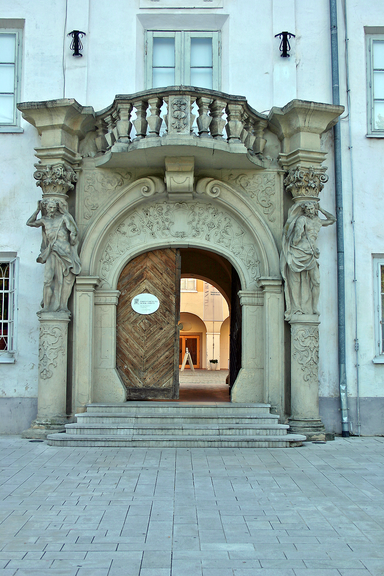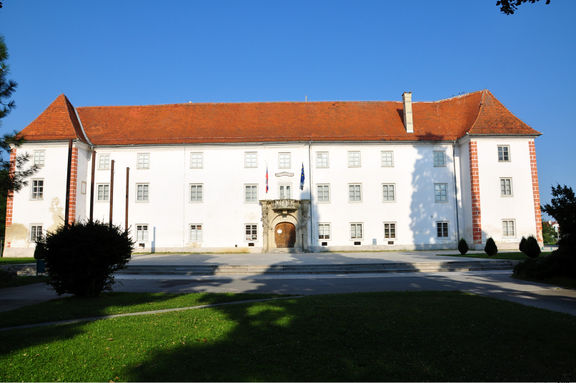-
to
30 Nov 2024
30 Mar 2025
GermanyHannoverWilhelm Busch – Deutsches Museum für Karikatur & Zeichenkunst"Ladislav Kondor: The Forgotten Cosmopolitan", the first international presentation of caricatures by Ladislav Kondor (1901-1963), a Slovenian autodidact and a world traveler, curated by Tamara Andrejek and co-organised by Pomurje Museum Murska Sobota. In cooperation with the Slovenian Cultural Centre in Berlin, Embassy of the Republic of Slovenia in Berlin.
-
24 Sep 2016
CroatiaDubrovnikTheatre Marin DržićA presentation by Metka Fujs (Murska Sobota Regional Museum) at 15th edition of The Best in Heritage: Projects of Influence
Institutional history
The beginnings of the Pomurje Museum Murska Sobota are connected with the Prekmurje Museum Society, which was established in 1935. The collection of the Prekmurje Museum Society was first indexed during the Second World War by Avgust Pavel. Since its move to the castle the museum has expanded its premises from the initial 186 square metres to an area of 2,000 square metres. In 1978 the museum became a working unit of Murska Sobota Cultural Centre, which was renamed in 1984 to Miško Kranjec Cultural Centre, Murska Sobota. In 1987 it acquired the status of general museum for Pomurje. It was established as an independent cultural institution in 1992 by the Municipality of Murska Sobota.
Programme and mission
The museum records, collects, researches, documents, conserves, educate, and presents all types of tangible and intangible cultural heritage. The intertwined cultural influences of the neighbouring provinces and countries have resulted in a unique creativity that comes from ethnic, national, and religious diversity. The museum performs a public service for all municipalities in this region and is also responsible for recording and documenting intangible heritage in Porabje (Hungary) and Radgona corner (Austria), where a part of the Slovene national minority lives. Its activity includes archaeology, ethnology, history and art history, conservation and restoration, and a professional library. The museum offers educational programmes for children and adults, including workshops and lecture activities.
Locations and branches
In addition to the main location at Murska Sobota Castle, the museum manages also museum exhibitions separate locations: the History of Health in Pomurje Region in the Beltinci Castle; the Bridges of Radgona in Špital, Gornja Radgona; Handicrafts Workshops and Domestic Activities in Grad Castle, Krajinski park Goričko; and the ethnological and social history exhibition about the Büjraš Workers on the Mura River in Ižakovci.
The museum has, however, professionally assisted also in the establishment of many local museum displays, such as the Memorial Room of Dr Fran Kovačič, Veržej; the former Radenska Museum Collection; Vaneča Memorial Room – District Committee of the Association of National Liberation War Veterans Murska Sobota; Miško Kranjec Homestead; the Memorial Room of Štefan Hozjan, Brezovica; Pečarovci Museum Collection of the Fire Brigade; the Memorial Room of Dr Anton Trstenjak, Rodmošci.
Collections
The collected material is arranged into different collections. The archaeological collection includes over 7,000 stone items, Eneolithic material from Šafarsko and Bukovnica, Bronze Age material from Dolnji Lakoš and Gornja Radgona, settlements in Dolga vas, Ivanci, sepulchral mounds and burial-grounds in Dobrovnik, Gančani, Vučja gomila, Gerlinci, Motvarjevci, Čikečka vas, Dokležovje, Rakičan, Strehovci and Mačkovci, Bronze Age settlement Oloris.
The ethnological collection' includes over 2,000 items of farming and household activities (a pottery collection, a shoemaker collection, a belt-making collection and a collection of farming utensils, folk art artefacts, recording elements of folk and mass culture ...). The toy collection was acquired in 2016 as a donation from a local family that has collected them since 1968.
The art history collection includes over 2,000 items of fine arts and crafts, art photography by Jožef Kološa, the legacy of painter Alojz Eberl, musical instruments, the collection of caricaturist Ladislav Kondor.
The history collection includes over 11,000 items of numismatics, photos, publications, technical objects, documents, textile items, smaller items and the library collection houses over 14,500 inventory units; and the medical collection of Pomurje region, collected by Nikolaj Szepessy, a doctor from Beltinci.
Exhibitions
The museum's main permanent collection, set up in autumn 1997, is located in the Murska Sobota Castle and presents life in the region along the Mura River from prehistoric times until today. For this exhibition the museum won the European Museum of the Year Award in 1999.
The temporary exhibitions cover interesting topics such as the ethnology of death rituals I'll be taken over this Doorstep when I Die [Prejk toga praga do me nesli, gda cujzapren oči] (2017) or One Needs to Depart this World Clean [Čist moraš s tega sveta] on the underwear, hygiene and beauty ideals in the Pomurje region (2011).
There are also many contemporary art exhibitions taking place in Murska Sobota Regional Museum; an exhibition in 2009 HA, this was an Artistic Soul was a part of a programme of the first International Ceramics Triennial Unicum.
Awards
The museum and its curators have won numerous awards. In 1998 the museum curators won the Valvasor Award for Curators. In 1987 Vlasta Koren won the Valvasor Award for Lifetime Achievement. The Plaque of the Municipality of Murska Sobota for Outstanding Achievements in the Field of Museology was received in 1992 by Irena Šavel and the Plaque of Municipality of Murska Sobota for Outstanding Achievements in the Field of Culture was received by Metka Fujs in 2001. In the same year Janez Balažic won the Izidor Cankar Award for Research in Medieval Painting and in 2002 he also received the Plaque of the Municipality of Murska Sobota for Outstanding Achievements in the Field of Culture. In 2003 the same award was bestowed also to Branko Kerman. The Valvasor Award for Exhibition-Project At the Turn of the Millenium was received by Metka Fujs in 2003. In the same year Irena Šavel received the Award of Archaeological Society of Slovenia for the book on Oloris.
Publishing
The periodical publication Anthology of Murska Sobota Regional Museum [Zbornik soboškega muzeja] is the first periodical publication in the region dedicated to sociology and science, published since 1990. Four documentary-feature films on time (Naravni in božji čas, Biografski čas, Merilci časa, Družbeni odnos do časa) directed by Aleš Nadai are the result of the project At the Turn of the Millennium. The museum regularly publishes exhibition catalogues, sound recordings, and other promotional material.
International cooperation
321 GO, a research and cultural heritage preservation project linking the three castles, owned by the Szapárys noble family was prepared in collaboration with the JOPERA Jennersdorf (KBB – Kultur-Betriebe Burgenland GmbH) and the Goričko Nature Park Public Institute. The Murska Sobota and Grad (Gornja Lendava) castles remained in Slovenia, while the Tabor castle, whose history is connected with nearby Neuhaus (Dobra) castle, is in Austria. The project was funded by the European Union under the European Regional Development Fund as part of the cooperation program Interreg V-A Slovenia-Austria (2016–2019) and is presented in an online monograph.
The cooperation with Lendava-Lendva Gallery and Museum and Pável Ágoston Museum in Monošter (Hungary) in the project "Sense of Place" started in 2009. The main goal was to realise a new permanent exhibition in Monošter and to renovate the premises for the realisation of the permanent educational programme in Murska Sobota, Lendava, and Monošter. The Murska Sobota Regional Museum takes part also in the international project "Handicrafts Academy".
See also
External links
- Pomurje Museum Murska Sobota website
- The 321 GO (Three Castles, Two Countries, One Story) project web site



